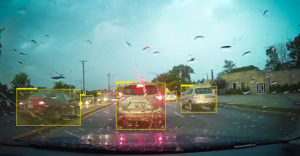Leading speakers from the three symposiums at this year’s Autonomous Vehicle Technology Expo ponder the key technologies required to bring about a new automotive era
Whether it arrives next year, in 10 years’ time, or in 20, an autonomous future is coming. To help make it happen, the automotive industry will convene in Stuttgart, Germany, on May 21, 22, 23 for Autonomous Vehicle Technology Expo 2019 and its three specialist conferences, where leading companies such as Uber, Cisco, IBM, Nvidia, Renault and Daimler will share exclusive insights into the future direction of AV development.
Safety will be on everyone’s minds, with manufacturers keen to prove AVs are reliably better than human drivers. However, it is a superhuman task: simulation and artificial intelligence are fundamental to ensuring AVs can competently deal with any situation they encounter.
A handful of manually written lines of code cannot even begin to deal with the complexity of even everyday traffic situations. As Olivier Bockenbach, from software company KPIT, explains, “The number of parameters that can influence the outcome of an evasive maneuver is so large that model-based approaches struggle to comprehensively take all these into account, let alone prioritize them to map out an ideal trajectory.”
 Hence the industry needs AI to help decipher and determine each and every scenario. And while cameras and lidar sensors grab headlines, featuring prominently on the roofs of AV prototypes, it is developments in software that will create true breakthroughs. “It is now becoming clear that meeting higher computational requirements is the key to mass-producing AVs,” says Assaf Mushinsky, chief scientist and co-founder of Brodmann17.
Hence the industry needs AI to help decipher and determine each and every scenario. And while cameras and lidar sensors grab headlines, featuring prominently on the roofs of AV prototypes, it is developments in software that will create true breakthroughs. “It is now becoming clear that meeting higher computational requirements is the key to mass-producing AVs,” says Assaf Mushinsky, chief scientist and co-founder of Brodmann17.
“There’s been a huge effort recently to improve hardware, software and especially algorithms so they can be used in real-world products with real-world pricing. In order to achieve substantial improvements in cost and efficiency and make the mass-production of AVs possible, the efficiency of the entire stack must be improved. Time and talent must be invested into the non-trivial algorithms that truly hold the potential for a change of an order of magnitude (or more) in power and accuracy – something that cannot be achieved by hardware progress alone.”
Keeping AI in check
AI is no silver bullet, though, since it cannot yet be trusted to get it right every time. And when AI makes the wrong inferences, the root causes are notoriously hard to track down, Bockenbach adds. Simulation technology exists to help spot mistakes before they have dangerous knock-on effects in the real world, and will be a major theme at this year’s Autonomous Vehicle Technology Expo. Established names such as Siemens, dSpace and AVL List GmbH will be demonstrating their most recent simulation developments, while agile startups such as Cognata and Latent Logic will be presenting their latest ideas at the conferences.
While simulation saves massive amounts of real-world testing time, effort and, ultimately, cost, building accurate and comprehensive simulation models and worlds for virtual AV and ADAS testing is a considerable challenge.

“The main challenge that we are currently facing is to capture as many edge cases as possible and to do this at increasing speed, while also scaling the operation to almost-infinity,” explains Danny Atsmon, CEO of Cognata.
“That means running each scenario across all possible permutations, with various traffic conditions, different weather conditions and different driving cultures. To achieve this, we need to be able to create a very realistic environment, replicate different driving cultures based on geographical traffic patterns, and present very high sensor and camera emulation capabilities. In addition, this needs to be done at massive scale while remaining purely artificial. It’s a colossal task.”
The real world

Despite ever-improving simulation capabilities, there is still a very real need for actual road testing. This is evidenced by the fact that the show floor of the Expo will be peppered with technologies to speed up the real-world testing process. For example, Dataspeed has developed a full ADAS kit that can be installed on a regular vehicle in under a day and can function as the testbed for a new hardware or software element, while StreetDrone will present a Renault Twizy kitted out with everything required to give new developments a taste of the real world.
Even Gianluca Vitale, from simulation veteran AVL, agrees that simulation can never be an end-to-end development tool. “Our idea is to try to make the in-vehicle testing phase as efficient as possible and reduce wasted time,” he says. “The intention is not to identify the scenario, run the simulation and call it a day. Instead, we want to identify the real scenarios that the testers in the car should focus on. The result will be more intensive usage of real data, of which there will be more and more, as we’re starting to get access to more in-use data from cars being run by the public. This kind of data is precious to us as it will help to reduce the amount of vehicle prototypes that get built.”
What about the humans?

It would seem human drivers will still be required for some time to keep an eye on their vehicles, which leads to the challenge of making sure they don’t doze off when they’re not supposed to. “Autonomous driving is a big enabler for driver monitoring systems in mass-production vehicles,” comments Wolfgang Stolzmann, lead engineer and consultant for ADAS systems at CMore Automotive. “To reach high and full automation (Levels 4 and 5), conditional automation (Level 3) must be established first.”
As increasingly automated functions reach production cars, many consumers interact with them without truly understanding their limitations – both over- and underestimating the capabilities of modern vehicles. Well-designed user experiences play a major part in the solution. “False expectations for ADAS systems can easily lead to misuse of the technology or an increase in driver distraction,” notes Rashmi Rao, global head, early customer engagement, at Harman.
“Current user experience issues with ADAS features demonstrate an urgent need for a well-thought-out human-machine collaboration. This means that the vehicle informs the user of the system limitations and influences user mental models to correctly understand how systems work. Finally, the UX should increase situation awareness, both of the vehicle status itself and of traffic situations.”
Ensuring that AVs, as well as semi-autonomous vehicles and those equipped with ADAS features, operate reliably and safely is a gargantuan task. This is why leading engineers from OEMs, Tier 1 suppliers and startups will trade insights at the Test & Development, Software & AI and Interior Design & Technology Symposiums on May 21, 22, 23. The three conferences combined boast over 120 expert speakers and are expected to attract hundreds of high-level attendees from across the automotive spectrum. The conferences take place at the free-to-attend Autonomous Vehicle Technology Expo, where the latest tech will be displayed at the booths of more than 90 exhibitors.
Register here for your free exhibition fast-track entry code.

Autonomous Vehicle Technology Expo is co-located with Automotive Testing Expo, the world’s largest vehicle test and development technologies exhibition, where visitors can see countless more AV and ADAS validation systems and services from leading names such as Millbrook, Mahle and Rohde & Schwarz.


